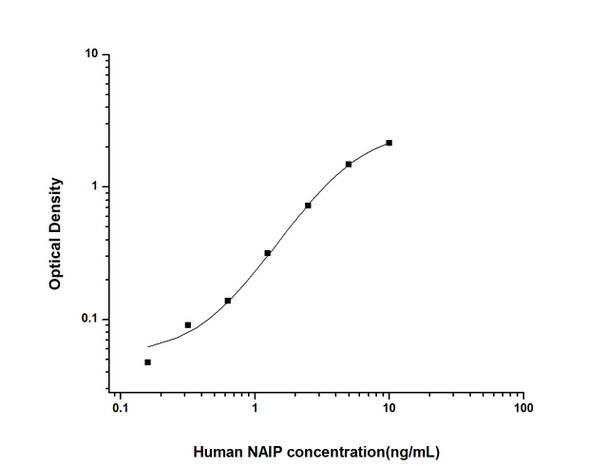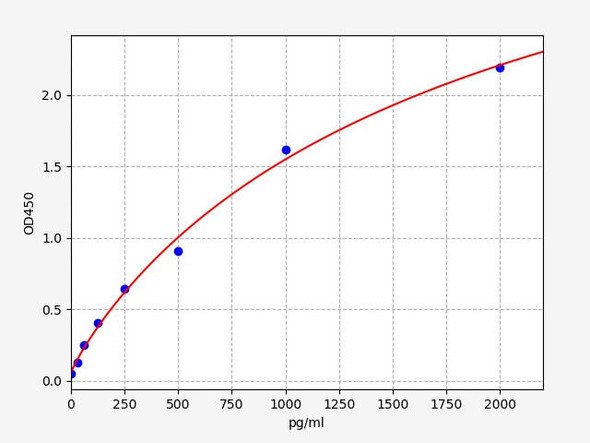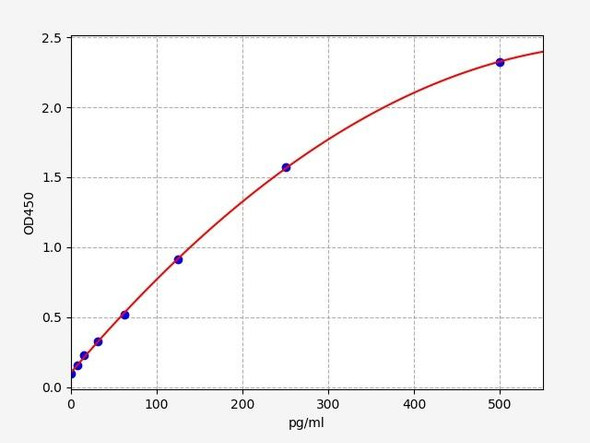Human Cell Death ELISA Kits
Human NAIP (Neuronal Apoptosis Inhibitory Protein) ELISA Kit (HUES02848)
- SKU:
- HUES02848
- Product Type:
- ELISA Kit
- Size:
- 96 Assays
- Uniprot:
- Q13075
- Sensitivity:
- 0.09ng/mL
- Range:
- 0.16-10ng/mL
- ELISA Type:
- Sandwich
- Reactivity:
- Human
- Sample Type:
- Serum, plasma and other biological fluids
- Research Area:
- Cell Death
Description
| Assay type: | Sandwich |
| Format: | 96T |
| Assay time: | 4.5h |
| Reactivity: | Human |
| Detection Method: | Colormetric |
| Detection Range: | 0.16-10 ng/mL |
| Sensitivity: | 0.10 ng/mL |
| Sample Volume Required Per Well: | 100µL |
| Sample Type: | Serum, plasma and other biological fluids |
| Specificity: | This kit recognizes Human NAIP in samples. No significant cross-reactivity or interference between Human NAIP and analogues was observed. |
This ELISA kit uses Sandwich-ELISA as the method. The micro ELISA plate provided in this kit has been pre-coated with an antibody specific to Human NAIP. Standards or samples are added to the appropriate micro ELISA plate wells and combined with the specific antibody. Then a biotinylated detection antibody specific for Human NAIP and Avidin-Horseradish Peroxidase (HRP) conjugate are added to each micro plate well successively and incubated. Free components are washed away. The substrate solution is added to each well. Only those wells that contain Human NAIP, biotinylated detection antibody and Avidin-HRP conjugate will appear blue in color. The enzyme-substrate reaction is terminated by adding Stop Solution and the color turns yellow. The optical density (OD) is measured spectrophotometrically at a wavelength of 450 nm ± 2 nm. The OD value is proportional to the concentration of Human NAIP. The concentration of Human NAIP in samples can be calculated by comparing the OD of the samples to the standard curve.
| UniProt Protein Function: | BIRC1: Anti-apoptotic protein which acts by inhibiting the activities of CASP3, CASP7 and CASP9. Can inhibit the autocleavage of pro-CASP9 and cleavage of pro-CASP3 by CASP9. Capable of inhibiting CASP9 autoproteolysis at 'Asp-315' and decreasing the rate of auto proteolysis at 'Asp-330'. Acts as a mediator of neuronal survival in pathological conditions. Prevents motor- neuron apoptosis induced by a variety of signals. Possible role in the prevention of spinal muscular atrophy that seems to be caused by inappropriate persistence of motor-neuron apoptosis: mutated or deleted forms of NAIP have been found in individuals with severe spinal muscular atrophy. |
| UniProt Protein Details: | Chromosomal Location of Human Ortholog: 5q13. 2 Cellular Component: basolateral plasma membrane; spindle microtubule; cytoplasm; nucleus Molecular Function:protein binding; metal ion binding; caspase inhibitor activity; ubiquitin-protein ligase activity; ATP binding Biological Process: nervous system development; regulation of signal transduction; innate immune response; protein ubiquitination; negative regulation of caspase activity; negative regulation of neuron apoptosis; inflammatory response; negative regulation of apoptosis |
| NCBI Summary: | This gene is part of a 500 kb inverted duplication on chromosome 5q13. This duplicated region contains at least four genes and repetitive elements which make it prone to rearrangements and deletions. The repetitiveness and complexity of the sequence have also caused difficulty in determining the organization of this genomic region. This copy of the gene is full length; additional copies with truncations and internal deletions are also present in this region of chromosome 5q13. It is thought that this gene is a modifier of spinal muscular atrophy caused by mutations in a neighboring gene, SMN1. The protein encoded by this gene contains regions of homology to two baculovirus inhibitor of apoptosis proteins, and it is able to suppress apoptosis induced by various signals. Alternatively spliced transcript variants encoding distinct isoforms have been found for this gene. [provided by RefSeq, Jul 2008] |
| UniProt Code: | Q13075 |
| NCBI GenInfo Identifier: | 219520065 |
| NCBI Gene ID: | 4671 |
| NCBI Accession: | AAI43762. 1 |
| UniProt Secondary Accession: | Q13075,O75857, Q13730, Q59GI6, Q8TDZ4, Q99796, B9EG72 E9PHD1, |
| UniProt Related Accession: | Q13075 |
| Molecular Weight: | 159,582 Da |
| NCBI Full Name: | NAIP protein |
| NCBI Synonym Full Names: | NLR family, apoptosis inhibitory protein |
| NCBI Official Symbol: | NAIP |
| NCBI Official Synonym Symbols: | BIRC1; NLRB1; psiNAIP |
| NCBI Protein Information: | baculoviral IAP repeat-containing protein 1; neuronal apoptosis inhibitory protein; psi neuronal apoptosis inhibitory protein; nucleotide-binding oligomerization domain, leucine rich repeat and BIR domain containing 1 |
| UniProt Protein Name: | Baculoviral IAP repeat-containing protein 1 |
| UniProt Synonym Protein Names: | Neuronal apoptosis inhibitory protein |
| Protein Family: | Putative niacin/nicotinamide transporter |
| UniProt Gene Name: | NAIP |
| UniProt Entry Name: | BIRC1_HUMAN |
As the OD values of the standard curve may vary according to the conditions of the actual assay performance (e. g. operator, pipetting technique, washing technique or temperature effects), the operator should establish a standard curve for each test. Typical standard curve and data is provided below for reference only.
| Concentration (ng/mL) | O.D | Average | Corrected |
| 10 | 2.212 2.228 | 2.22 | 2.142 |
| 5 | 1.544 1.566 | 1.555 | 1.477 |
| 2.5 | 0.818 0.784 | 0.801 | 0.723 |
| 1.25 | 0.378 0.41 | 0.394 | 0.316 |
| 0.63 | 0.224 0.208 | 0.216 | 0.138 |
| 0.32 | 0.17 0.166 | 0.168 | 0.09 |
| 0.16 | 0.121 0.129 | 0.125 | 0.047 |
| 0 | 0.073 0.083 | 0.078 | -- |
Precision
Intra-assay Precision (Precision within an assay): 3 samples with low, mid range and high level Human NAIP were tested 20 times on one plate, respectively.
Inter-assay Precision (Precision between assays): 3 samples with low, mid range and high level Human NAIP were tested on 3 different plates, 20 replicates in each plate.
| Intra-assay Precision | Inter-assay Precision | |||||
| Sample | 1 | 2 | 3 | 1 | 2 | 3 |
| n | 20 | 20 | 20 | 20 | 20 | 20 |
| Mean (ng/mL) | 0.54 | 1.03 | 4.61 | 0.58 | 1.08 | 4.20 |
| Standard deviation | 0.03 | 0.05 | 0.19 | 0.04 | 0.05 | 0.16 |
| C V (%) | 5.56 | 4.85 | 4.12 | 6.90 | 4.63 | 3.81 |
Recovery
The recovery of Human NAIP spiked at three different levels in samples throughout the range of the assay was evaluated in various matrices.
| Sample Type | Range (%) | Average Recovery (%) |
| Serum (n=5) | 87-100 | 92 |
| EDTA plasma (n=5) | 94-107 | 101 |
| Cell culture media (n=5) | 95-110 | 101 |
Linearity
Samples were spiked with high concentrations of Human NAIP and diluted with Reference Standard & Sample Diluent to produce samples with values within the range of the assay.
| Serum (n=5) | EDTA plasma (n=5) | Cell culture media (n=5) | ||
| 1:2 | Range (%) | 96-113 | 84-98 | 93-107 |
| Average (%) | 104 | 90 | 100 | |
| 1:4 | Range (%) | 86-98 | 81-93 | 83-98 |
| Average (%) | 93 | 87 | 90 | |
| 1:8 | Range (%) | 91-104 | 81-91 | 85-98 |
| Average (%) | 97 | 85 | 91 | |
| 1:16 | Range (%) | 93-108 | 84-96 | 83-97 |
| Average (%) | 99 | 90 | 89 |
An unopened kit can be stored at 4°C for 1 month. If the kit is not used within 1 month, store the items separately according to the following conditions once the kit is received.
| Item | Specifications | Storage |
| Micro ELISA Plate(Dismountable) | 8 wells ×12 strips | -20°C, 6 months |
| Reference Standard | 2 vials | |
| Concentrated Biotinylated Detection Ab (100×) | 1 vial, 120 µL | |
| Concentrated HRP Conjugate (100×) | 1 vial, 120 µL | -20°C(shading light), 6 months |
| Reference Standard & Sample Diluent | 1 vial, 20 mL | 4°C, 6 months |
| Biotinylated Detection Ab Diluent | 1 vial, 14 mL | |
| HRP Conjugate Diluent | 1 vial, 14 mL | |
| Concentrated Wash Buffer (25×) | 1 vial, 30 mL | |
| Substrate Reagent | 1 vial, 10 mL | 4°C(shading light) |
| Stop Solution | 1 vial, 10 mL | 4°C |
| Plate Sealer | 5 pieces | |
| Product Description | 1 copy | |
| Certificate of Analysis | 1 copy |
- Set standard, test sample and control (zero) wells on the pre-coated plate and record theirpositions. It is recommended to measure each standard and sample in duplicate. Note: addall solutions to the bottom of the plate wells while avoiding contact with the well walls. Ensuresolutions do not foam when adding to the wells.
- Aliquot 100µl of standard solutions into the standard wells.
- Add 100µl of Sample / Standard dilution buffer into the control (zero) well.
- Add 100µl of properly diluted sample (serum, plasma, tissue homogenates and otherbiological fluids) into test sample wells.
- Cover the plate with the sealer provided in the kit and incubate for 90 min at 37°C.
- Aspirate the liquid from each well, do not wash. Immediately add 100µL of BiotinylatedDetection Ab working solution to each well. Cover the plate with a plate seal and gently mix. Incubate for 1 hour at 37°C.
- Aspirate or decant the solution from the plate and add 350µL of wash buffer to each welland incubate for 1-2 minutes at room temperature. Aspirate the solution from each well andclap the plate on absorbent filter paper to dry. Repeat this process 3 times. Note: a microplatewasher can be used in this step and other wash steps.
- Add 100µL of HRP Conjugate working solution to each well. Cover with a plate seal andincubate for 30 min at 37°C.
- Aspirate or decant the solution from each well. Repeat the wash process for five times asconducted in step 7.
- Add 90µL of Substrate Reagent to each well. Cover with a new plate seal and incubate forapproximately 15 min at 37°C. Protect the plate from light. Note: the reaction time can beshortened or extended according to the actual color change, but not by more than 30min.
- Add 50 µL of Stop Solution to each well. Note: Adding the stop solution should be done inthe same order as the substrate solution.
- Determine the optical density (OD value) of each well immediately with a microplate readerset at 450 nm.






